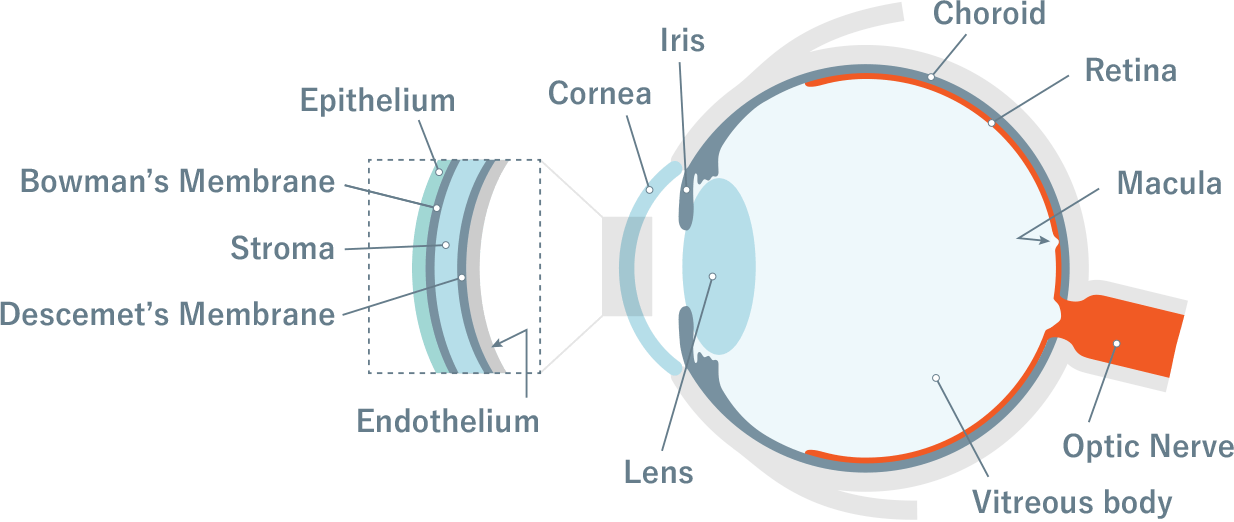HISTORY OF
CORNEAL TRANSPLANTATION
Cornea Transplantation in Japan and Overseas

- 1789Corneal transplant using glass attempted by French ophthalmologist, Guillaume Pellier de Quengsy
- 1924Successful transplantation of a cornea from a human corpse conducted by Prof. Vladimir Filatov, Odessa University
- 1945World’s first eye bank founded in New York, USA
- 1949First corneal transplant performed in Japan by Prof. Kitetsu Imaizumi of Iwate Medical University
- 1956Prof. Imaizumi established his own version of an eye bank in Iwate Medical University
- April 17, 1958Cornea Transplantation Law announced in Japan (enforced on July 16 of the same year)
- June 28, 1963Eye Donation Business Licensing system established by Japan’s Ministry of Health and Welfare
- October 1963First licensed eye banks established in Japan (Keio University Eye Bank, Juntendo Eye Bank, and subsequent eye banks opened in various locations)
- December 18, 1979Cornea and Kidney Transplantation Law announced in Japan (enforced on March 18 of the following year)
- July 16, 1997Organ Transplantation Law announced in Japan (enforced on October 16 of the same year)
- July 17, 2010Current Organ Transplantation Law enacted (54 eye banks are currently operating under this law)
The cornea is the transparent tissue at the very front of the eye. There are various diseases that affect the cornea, such as keratoconus, bullous keratopathy, bacterial or viral infection, and corneal leukoplakia. The procedure known as a cornea transplant replaces all or part of a clouded cornea, due to disease or damage, with transparent donor tissue.
Eye donation is possible regardless of nearsightedness, farsightedness, astigmatism, presbyopia, syphilis, or age provided the cornea is transparent. However, donation may not be possible in the case of a donor with a potentially infectious disease – such as COVID-19. *1 There are 19,000 people in Japan with visual impairment due to corneal diseases, and about 2,200 patients nationwide are awaiting corneal transplants. *2
Data from the Gain’s report, Global Survey on Corneal Transplantation and Eye Banking, shows that there are approximately 12.7 million people in 134 countries waiting for a transplant, while only 185,000 corneal transplants are performed each year in 116 countries. *3
More than half of the patients needing corneal transplants suffer from bullous keratopathy, which is caused by edema of the cornea resulting from the dysfunction of corneal endothelial cells. There are two major factors that contribute to the development of bullous keratopathy: hereditary disease and surgical complications. Hereditary disease is represented by Fuchs’ corneal endothelial degeneration, a type of corneal dystrophy that develops in patients 50-60 years old. In terms of complications, bullous keratopathy can occur due to severe trauma to the endothelial cells during surgery for cataracts, glaucoma, or other eye conditions.
The factors causing bullous keratopathy differ slightly by country. In Europe and the USA, the disease is predominantly hereditary, while in Japan and other Asian countries, it is often the result of complications from cataract or other intraocular surgery. Regenerative treatment of the corneal endothelium, which is not dependent on eye banks, can help eliminate the large corneal transplant supply-demand mismatch and reduce the number of corneal blindness cases worldwide.
-
*1
Impact of the COVID-19 Pandemic on Corneal Transplantation and Cornea Procurement
Six corneal transplants were performed between March 2020 and February 2021 (group A), compared to 48 during the previous year (group B). This constitutes an 80% year-on-year decline in total corneal transplants, while lamellar surgeries were not performed at all during the first year of the pandemic.
-
*2
Keratoplasty Society of Japan
In 2014, there were 10,883 registered eye donors, 927 actual eye donors, 1,476 transplants, and 2,200 patients on the waiting list as of the end of March 2014, while the number of visually impaired people due to corneal disease stood at 19,000.
- *3 Global Survey of Corneal Transplantation and Eye Banking

